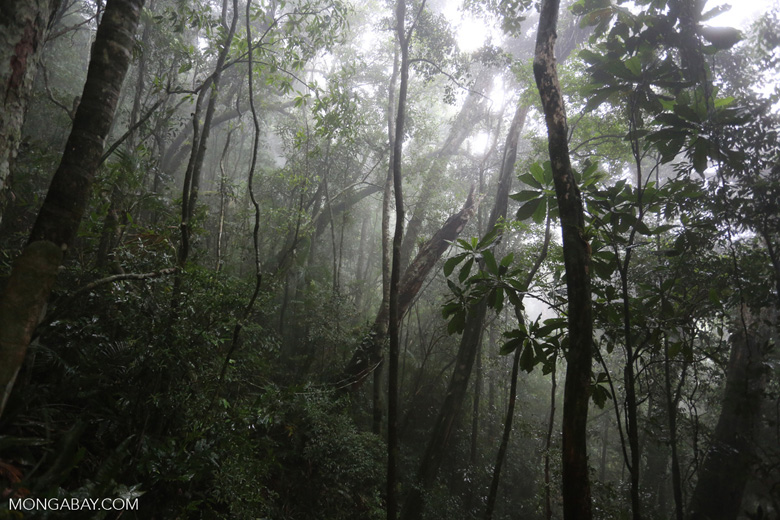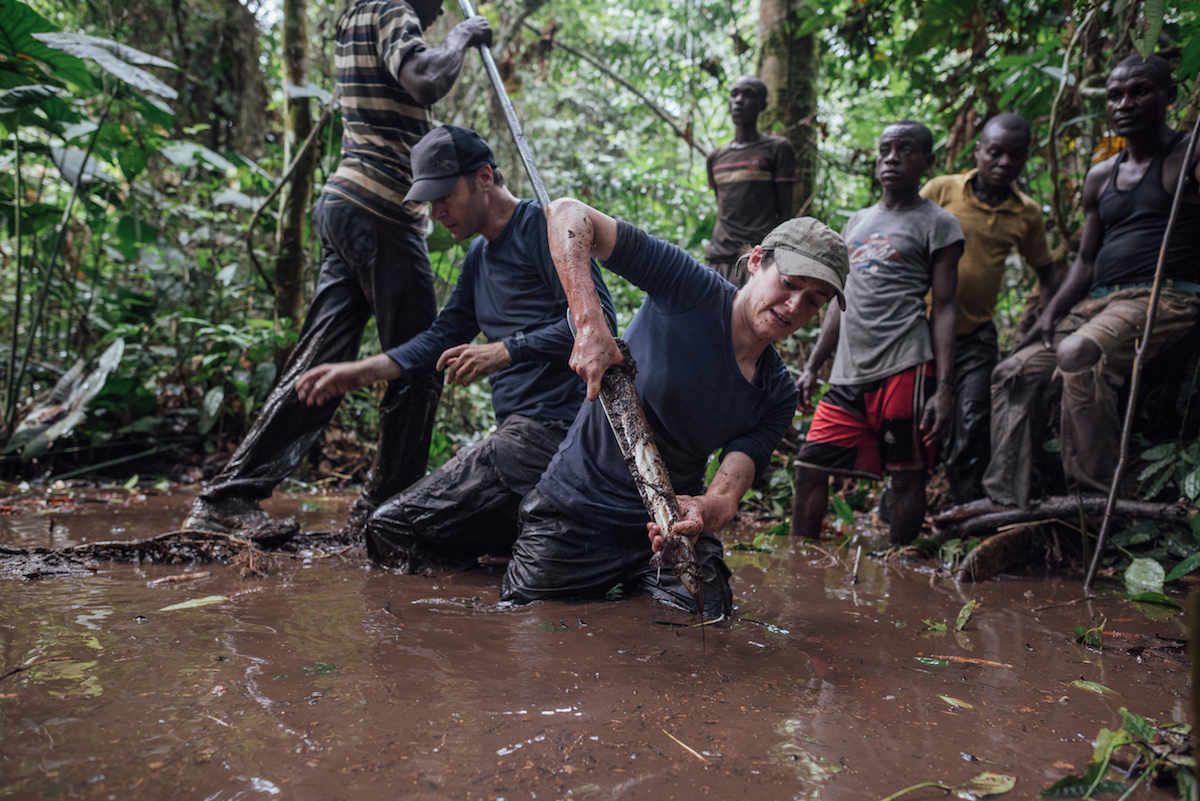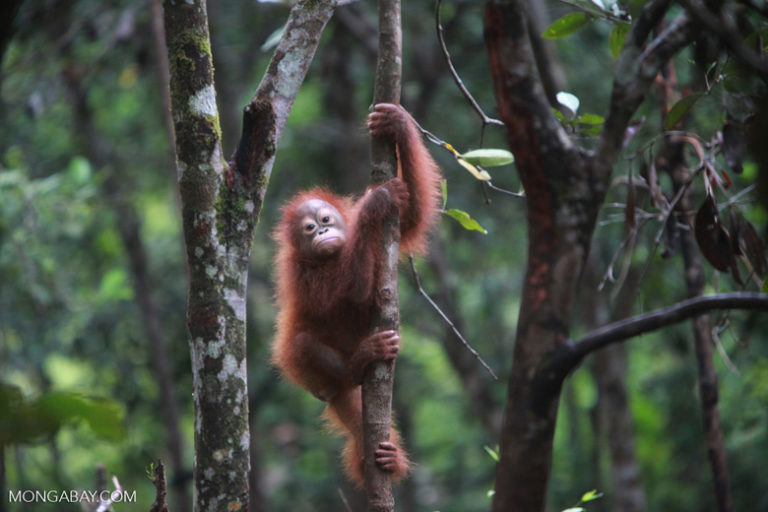Mongabay published hundreds of stories on forests in 2017. Here are some of our favorites.
1. Rebel road expansion brings deforestation to remote Colombian Amazon
With the demobilization of Colombia’s FARC militant group, the country is expanding agriculture and infrastructure in places in the country once too dangerous to develop. One of these areas is a stretch of rainforest in the Colombian Amazon. A small road that was initially carved illegally through the forest and used by the FARC to transport coca is in the process of being widened and paved to help communities transport their agricultural goods to larger markets. But conservationists are criticizing the project, saying road expansion will incite land-grabbing, the illegal development of more roads and accelerated deforestation.
2. Indigenous groups, activists risk arrest to blockade logging in Malaysia
The Malaysian state of Kelantan has seen an uptick in deforestation as tree plantations expand. Deep in the rainforests in the northern part of the state, anti-logging campaigns are setting up blockades along logging roads to try to deter logging companies from entering forests claimed by indigenous Orang Asli communities – a claim upheld by Malaysian high courts. However, activists and community members say logging continues in the area, and they vow to continue their blockades against deforestation despite repeated arrests of their members.

3. The palm oil fiefdom
Today, oil palm covers more than a fifth of the district of Seruyan in Indonesian Borneo. Ninety-six percent of it is owned by the super-rich, and profits flow out to the capitals of Jakarta, Singapore and Kuala Lumpur. Only a fraction of the taxes collected by the state find their way back to Seruyan. Over nine months, The Gecko Project and Mongabay investigated the land deals that were done in Seruyan during its transition to democracy. Investigators followed the trails of paper and money, tracked down the people involved and talked to those affected by Darwan’s actions. It was a journey that took them from law firms in Jakarta to a prison in Borneo, from backwater legislatures to villages that stand like islands amid a sea of oil palm.
4. Cross River superhighway changes course in Nigeria
A major new road is in development through southeastern Nigeria that will connect landlocked cities with the port of Calabar on the Gulf of Guinea. The six-lane superhighway was originally slated to run through the center of Cross River National Park, a biodiversity hotspot and home to endangered wildlife like drills, Nigeria-Cameroon chimpanzees and Cross River gorillas – the rarest and most threatened of the world’s gorilla subspecies. But after conservationists raised the alarm about the environmental perils the road may bring, the Nigerian government altered the path of the superhighway from the middle of the national park to outside its western periphery. The move is being celebrated by conservation organizations, but concern still exists about the highway’s new path through forested areas and protected lands.
5. Forest fragmentation may be releasing much more carbon than we think
Many of the world’s tropical forests have been severely fragmented by human disturbance, and research has shown the trees that live on the edges of these fragments are more likely to die than those living in the fragment interiors. With this death comes the release of carbon as trees decompose. A 2017 study published in Nature Communications found that the carbon released by this higher tree mortality at fragment edges increases deforestation emission estimates by 31 percent. In total, the researchers found there are around 50 million tropical forest fragments today and, put together, their edges would span a third of the distance from the earth to the sun.

6. Tropical deforestation is getting bigger
As nations race to keep forests standing and the world from warming, scientists are trying to figure out what human activities are causing deforestation and how best to stop them. A study published earlier this year in Environmental Research Letters lends some new insights, finding the majority of forest loss in the tropics is due to medium- and large-scale clearing, which are hallmarks of industrial agriculture like palm oil production. South America and Southeast Asia had the largest increases in these larger clearing activities. The researchers who authored the study say policy changes are needed to reduce deforestation for commodity crops.
7. ‘Last frontiers of wilderness’: Intact forest plummets globally
Research published this year found that between 2000 and 2013, the world lost a Venezuela-sized area of untouched forests – what scientists call intact forest landscapes (IFLs). The study shows more than 7 percent of the world’s IFLs disappeared during that time. This loss appears to be accelerating in the tropics, with three times more IFLs lost between 2011 and 2013 than between 2001 and 2003. Paraguay was the most affected, losing nearly 90 percent of its remaining IFLs over 13 years. Timber harvesting and agricultural expansion are considered the leading causes of IFL loss.
8. Charcoal and cattle ranching tearing apart the Gran Chaco
Paraguay’s Gran Chaco has one of the highest rates of deforestation in the world, with nearly 1 million hectares of tree cover lost in 2008 alone. The Chaco is home to many unique species, such as the endangered Chacoan peccary or taguá. Soy cultivation, cattle ranching and charcoal production are major drivers of Chaco deforestation. A year-long probe by the non-profit organization Earthsite revealed that most Paraguayan exports of charcoal come from the Chaco and are marketed as sustainably sourced, but may not actually meet sustainability certification requirements. This charcoal is sold in several international supermarket chains.
9. World’s largest tropical peatlands discovered in swamp forests of Congo Basin
The discovery of the world’s largest tropical peatland was announced earlier this year. The huge peatland is located in the vast rainforests of the Congo Basin and straddles two countries – the Democratic Republic of the Congo (DRC) and the Republic of the Congo – and comprises an area larger than England. The researchers who discovered it initially estimated it contained around 30 billion metric tons of carbon. But subsequent surveys revealed the peat swamp to be deeper than they first thought, and it likely stores even more carbon. Movement by the DRC to open more forests in the region to logging and other development are prompting concern from conservationists who worry that draining the peatland could release significant amounts of greenhouse gas.

10. Do protected areas work in the tropics?
A meta-analysis of 56 scientific studies by Mongabay revealed that, overall, protected areas appear to reduce deforestation. But other ecological effects of protected areas, like biodiversity or poaching, remain very understudied. But ultimately, there has been a lack of rigorous study of the efficacy of protected areas. What scientific literature does exist suggests that terrestrial protected areas help reduce deforestation, but to varying degrees. In some places, parks avoid high rates of forest loss; in others, the effects are modest to negligible. But finer details about the health of protected forests (the status of biodiversity, levels of hunting or logging) are harder to get. The evidence on socioeconomic impacts is very thin. What limited rigorous research exists shows that protected areas do not exacerbate poverty generally, but anecdotal studies suggest that protected areas could be making other aspects of people’s well-being worse off.
11. Does community-based forest management work in the tropics?
Community-based forest management, a conservation strategy in which local communities are in charge of the forests they live within, is often touted as a one-stop solution for everything from improving forest health to reducing poverty. A review of 30 studies revealed that community-based forest management may improve forest conditions. Results on socio-economic benefits is mixed, but research suggests that community-based forest management may occasionally exacerbate prevailing inequities within communities. In addition to improving forests, community-based forest management tries to ensure their sustainable use. However, there is very little research on whether community-managed forests are actually sustainable over the long term.
12. Sudden sale may doom carbon-rich rainforest in Borneo
A pristine tract of rainforest known as Forest Management Unit 5 (FMU5) encompasses more than 101,000 hectares in central Sabah, a Malaysian state on the island of Borneo. The area provides important habitat for Bornean orangutasn and other endangered species, and safeguards watersheds critical to downstream communities. Conservation groups had been working with the state government and concession owner to set up a concept conservation economy on FMU5. But in October, the rights to the land were acquired by wood product manufacturing company Priceworth.
13. Paying for healthcare with trees: win-win for orangutans and communities
In 2016, the Bornean orangutan (Pongo pygmaeus) was declared Critically Endangered by the IUCN. Orangutan habitat is fast disappearing due to deforestation from agriculture and logging. One of the most important remaining P. pygmaeus populations, with roughly 2,000 individuals, is in Indonesia’s Gunung Palung National Park. Two non-profit organizations — one based in Indonesia and another from the U.S. — united to try to reduce illegal logging in the park through a novel, healthcare-based approach. They discovered that many people reported logging because of expensive medical costs, while unsustainable agricultural practices depleted the soil of nutrients, requiring the use of costly fertilizers. The two NGOs opened an affordable health clinic and hospital, offering discounted medical services to communities that stop logging. “Forest guardians” recruited from participating villages, encourage people to curb deforestation while monitoring illegal activity and reforestation efforts and educating residents about organic farming methods.

14. Over the bridge: The battle for the future of Kinabatangan
The Kinabatangan River and the wildlife sanctuary named for it threw the state of Sabah into the global spotlight this year as the proposal of a bridge crossing the river from the town of Sukau across attracted local and international opposition. Project proponents say that a bridge and associated paved road to Sukau would have helped the town grow and improve its residents’ standard of living. But conservation groups argue that the region has potential for high-end nature tourism that could result in similar economic benefits without disturbing the elephants, orangutans and other wildlife that depend on the region’s forests. In mid-April the bridge was cancelled, a move heralded as a success for rainforest conservation. But bigger questions remain about the future of local communities, the Kinabatangan sanctuary and the region’s wildlife.
15. Record Amazon fires stun scientists; sign of sick, degraded forests
By mid-October, Brazil had experienced more than 208,000 fires, putting 2017 on track to beat 2004’s record 270,295 fires. While drought has exacerbated the fires, experts say that nearly every blaze this year has been human-caused. In September, the highest concentration of fires in the Brazilian Amazon was in the São Félix do Xingu and Altamira regions. September fires in Pará numbered 24,949 – a six-fold increase over the 3,944 recorded in the same month in 2016. The Amazonian regions experiencing the most wildfires have also seen high levels of deforestation and degradation as logging, cattle ranching, agribusiness and dam-building expand. Scientists warn of a dangerous synergy in which forest degradation is turning the Amazon from carbon sink to carbon source in some dry years, while human carbon emissions are worsening drought and fires globally. Researchers warn of the coming of bigger “mega-fires” unless trends are reversed.
16. Mining activity causing nearly 10 percent of Amazon deforestation
In results published this year, scientists announced that nearly 10 percent of the deforestation in the Brazilian Amazon between 2005 and 2015 was due to mining activities — up from a previous estimate of 1 to 2 percent. They found mining-related deforestation present in areas up to 70 kilometers away from actual mines. To address the high level of deforestation caused by mining in the Amazon, conservationists say Brazil needs to significantly revise its environmental impact assessment process to include ancillary infrastructure up to 70 kilometers away from mines along with related hydroelectric dam construction.
17. Indigenous forests could be a key to averting climate catastrophe
A study published in Science in October found the world’s tropical forests may no longer be carbon sinks, with a net loss of 425 million tons of carbon from 2003 to 2014. In addition, 1.1 billion metric tons of carbon is emitted globally per year due to land use of forested areas (4.4 billion metric tons are absorbed by standing forests on managed lands, but 5.5 billion metric tons are released via deforestation and degradation). As a result, curbing deforestation and degradation is now considered a key strategy for nations to meet their carbon reduction goals and keep global warming under 2 degrees Celsius in accordance with the Paris Agreement. Research finds that indigenous and traditional community management of forests could offer a key to curbing emissions, and give the world time to transition to a green energy economy. Scientists found Amazon deforestation rates were around five times higher outside indigenous territories and conservation units than inside. A delegation of global indigenous delegation in attendance at COP23 in Bonn, Germany, are conducting a campaign to solicit support from the world’s nations to protect indigenous forests from encroachment by extraction industries.

18. Women could be a key to great ape conservation in the Congo
Women have suffered a heavy toll from violence in the Democratic Republic of the Congo (DRC). The nation’s civil struggle, together with bushmeat hunting and other kinds of human pressures, also affect its wildlife such as gorillas, bonobos and chimpanzees. Scientific surveys indicate bonobos have been vanishing rapidly from DRC forests over the past 20 years. Meanwhile, researchers estimate only around 3,800 Grauer’s gorillas remain, and the subspecies is listed as Critically Endangered by the IUCN. Chimpanzees are listed by the IUCN as Endangered. But now, DRC women, assisted by international conservation organizations, are working to protect apes and other DRC wildlife. The organizations foster a variety of projects, from funding micro-credit projects for women who want to launch business enterprises to employing women as surrogate mothers for newly orphaned gorillas during an initial 30-day quarantine period and training women in livestock breeding and agriculture to reduce great ape hunting.
19. Oil palm firms advance into Leuser rainforest, defying Aceh governor’s orders
The Leuser Ecosystem straddles lies in northern Sumatra and is home to an array of rare animals, including rhinos, elephants, tigers and orangutans. The government of Indonesia’s Aceh province has banned land clearance for oil palm development inside Leuser. However, deforestation is still ongoing as some companies ignore the moratorium. During the first seven months of 2017, conservation watchdogs report Leuser lost 3,941 hectares of forest cover.
20. Conserving Congo’s wild places on a shoestring
The 76,000-hectare (around 188,000-acre) Mangrove Marine Park, 250 miles west of Kinshasa, is an expanse of ocean, beach, savannah and mangroves that hugs Congo’s 23-mile strip of coastline. The park operates on a budget so small, staff say they can hardly afford to patrol it. Though the beach and savannah portions of the park are partially protected areas, a handful of communities have continuously lived there since long before the park’s creation. Park officials and rangers face the difficult task of protecting the vast area with just a handful of rangers and are up against generations of ingrained practices by residents, such as poaching turtles and their eggs. The park’s future rests on the ability of the its director to raise more money while persuading those who live in and around the site that conservation is in their best interest.
Banner image by Rod Harbinson/RodHarbinson.com
FEEDBACK: Use this form to send a message to the editor of this post. If you want to post a public comment, you can do that at the bottom of the page.
